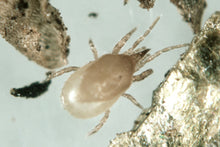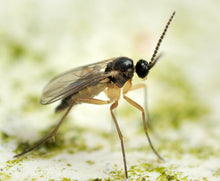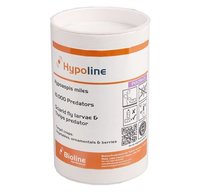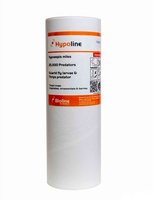
These mites are one of the most effective killers of sciarid fly larvae.
Mobile predatory mites that feed on sciarid fly larvae and other 'soil' pests including springtails, thrips pupae and root mealybug. Adults are reported to live for several months and survive up to 50 days without food, making them ideal in situations of very low pest populations. At night they move a short distance up, on to the plant foliage and will feed on mealybug and other soft bodied prey. Mites are very mobile and soon distribute themselves throughout the crop.
Sold in 2 sizes. Orders placed by 10am Monday will be despatched later in the week.
Further information
How much do I need?
When to use
How to use
These are tiny crawling beneficial mites which eat rotting material and insect larvae. They are sometimes called "flour mites" because they were typically found in empty flour bags. They live in the very top layers of soil or compost, and scavenge around looking for prey. The eggs are laid in the top layers of the compost and hatch into a six-legged and then eight-legged spidery larva, which reach adulthood some 18 days later (slower if the temperature is under 20°C).
Hypoaspis are also known to feed on other soil dwelling pests such as springtails and thrip larvae. They may also move up the plant at night and feed in small amounts on soft bodied pests such as mealybug.
Even when fully grown Hypoaspis are only 1mm long, so they are pretty difficult to identify, however if you look at a colony you will just be able to see some moving specks with a magnifying glass.
A shaker tub of 10,000 mites should be enough for at least 200 per square metre of surface area. However, you cannot overdose the treatment, higher application rates will result in quicker clear up rates.
Use at the first sign of the pest or as a preventative control.
To be most effective the soil temperature needs to be above 12°C, and the Hypoaspis are a lot more effective at higher temperatures. These mites have the reputation of living for quite a long time without food, when they have been previously fed, so they are good for situations where the pest population is low. Hypoaspis will not become a pest in their own right because their population fluctuates with their prey and they are harmless to children and pets. They tolerate a variety of conditions, except flooding but are inactive below 8°C.
Inside the tube you will see packing material, usually bran husks, this is included to protect the predatory mites and to stop them from eating each other. The mites are among the packing material but they are scarcely visible to the naked eye – they are brown coloured and only about 1mm long when fully grown. With the aid of the microscope you can see that the male is thin while the female has a bulbous body, thick front legs and long mouth parts.
Mix the predators evenly through the carrier material by gently rotating and tilting the rub. Remove the lid and scatter the husks on the soil among the plants.







